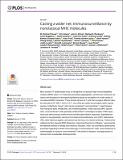| dc.contributor.author | Birnbaum, Michael E. | |
| dc.date.accessioned | 2020-03-31T18:04:56Z | |
| dc.date.available | 2020-03-31T18:04:56Z | |
| dc.date.issued | 2019-02-21 | |
| dc.identifier.issn | 1553-7374 | |
| dc.identifier.uri | https://hdl.handle.net/1721.1/124454 | |
| dc.description.abstract | Most studies of T lymphocytes focus on recognition of classical major histocompatibility complex (MHC) class I or II molecules presenting oligopeptides, yet there are numerous variations and exceptions of biological significance based on recognition of a wide variety of nonclassical MHC molecules. These include αβ and γδ T cells that recognize different class Ib molecules (CD1, MR-1, HLA-E, G, F, et al.) that are nearly monomorphic within a given species. Collectively, these T cells can be considered “unconventional,” in part because they recognize lipids, metabolites, and modified peptides. Unlike classical MHC-specific cells, unconventional T cells generally exhibit limited T-cell antigen receptor (TCR) repertoires and often produce innate immune cell-like rapid effector responses. Exploiting this system in new generation vaccines for human immunodeficiency virus (HIV), tuberculosis (TB), other infectious agents, and cancer was the focus of a recent workshop, “Immune Surveillance by Non-classical MHC Molecules: Improving Diversity for Antigens,” sponsored by the National Institute of Allergy and Infectious Diseases. Here, we summarize salient points presented regarding the basic immunobiology of unconventional T cells, recent advances in methodologies to measure unconventional T-cell activity in diseases, and approaches to harness their considerable clinical potential. | en_US |
| dc.language.iso | en | |
| dc.publisher | Public Library of Science (PLoS) | en_US |
| dc.relation.isversionof | 10.1371/journal.ppat.1007567 | en_US |
| dc.rights | Creative Commons Attribution 4.0 International license | en_US |
| dc.rights.uri | https://creativecommons.org/licenses/by/4.0/ | en_US |
| dc.source | PLoS | en_US |
| dc.subject | Immunology | en_US |
| dc.subject | Genetics | en_US |
| dc.subject | Molecular Biology | en_US |
| dc.subject | Microbiology | en_US |
| dc.subject | Parasitology | en_US |
| dc.subject | Virology | en_US |
| dc.title | Casting a wider net: Immunosurveillance by nonclassical MHC molecules | en_US |
| dc.type | Article | en_US |
| dc.identifier.citation | D’Souza, M. Patricia et al. "Casting a wider net: Immunosurveillance by nonclassical MHC molecules." PloS one 15 (2019) | en_US |
| dc.contributor.department | Massachusetts Institute of Technology. Department of Biological Engineering | en_US |
| dc.relation.journal | PloS one | en_US |
| dc.eprint.version | Final published version | en_US |
| dc.type.uri | http://purl.org/eprint/type/JournalArticle | en_US |
| eprint.status | http://purl.org/eprint/status/PeerReviewed | en_US |
| dc.date.updated | 2020-02-11T13:17:12Z | |
| dspace.date.submission | 2020-02-11T13:17:14Z | |
| mit.journal.volume | 15 | en_US |
| mit.journal.issue | 2 | en_US |
| mit.license | PUBLISHER_CC | |
| mit.metadata.status | Complete | |
